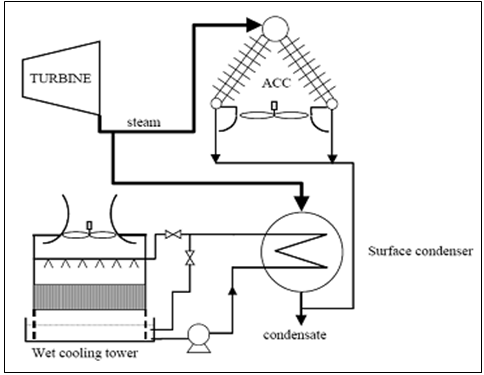Hybrid Cooling

Though largely not used in the United States, hybrid systems (Figure 1) involve both wet and dry units that run in parallel or use water to cool air going to the air-cooled condenser. In a parallel cooling system, the dry unit is the primary heat rejection system and is used exclusively for the majority of the time during operation.1 When the ambient air temperature reaches higher temperatures, typical of a summer day in the desert Southwest, part of the steam leaving the turbine generator is routed to a wet cooling unit. By reducing the load on the air- cooled condenser, the dry unit can bring the condenser steam temperature closer to the design condenser temperature on hotter days.2 Hybrid systems have been found to reduce water consumption by 50 percent with only a one percent drop in annual electricity output.3 Hybrid systems that reduce water consumption compared to wet cooled systems and provide enhanced performance in warmer climates compared to dry cooled systems are of great interest for CSP applications.
1 Jürgen Dersch and Christoph Richter, Institute of Technical Thermodynamics, Deutsches Zentrum fur Luft-und Raumfarht Study, “Water saving heat rejection for solar thermal power plants”, 2007.
2 Jürgen Dersch and Christoph Richter, Institute of Technical Thermodynamics, Deutsches Zentrum fur Luft-und Raumfarht Study, “Water saving heat rejection for solar thermal power plants”, 2007.
3 Statement of Kristina M. Johnson, Under Secretary of Energy U.S. Department of Energy before the Committee on Science and Technology, Subcommittee on Energy and Environment U.S. House of Representatives, July 9, 2009.
